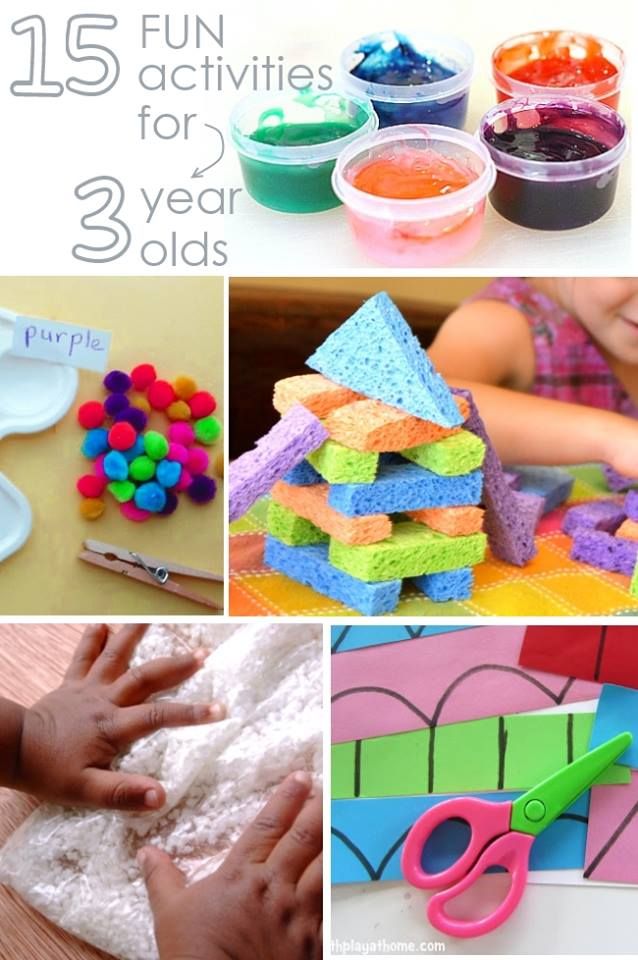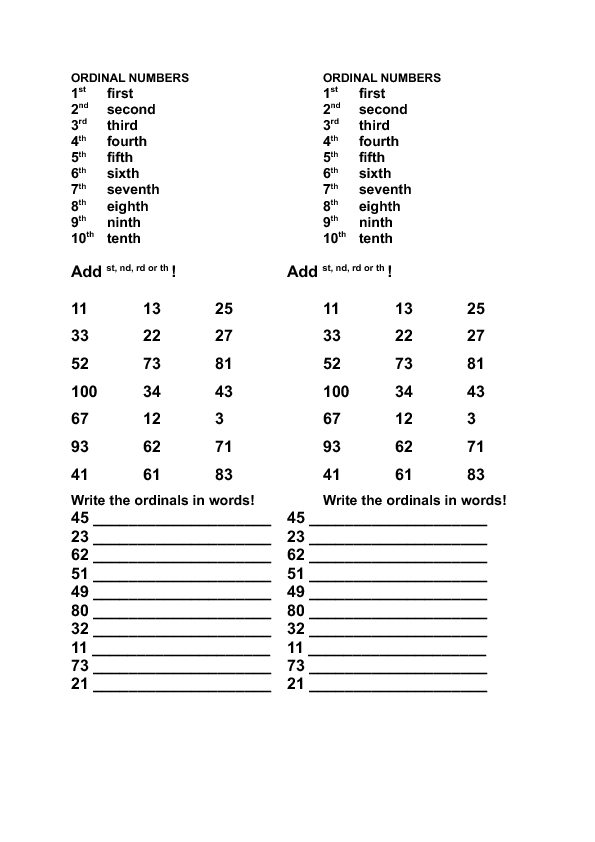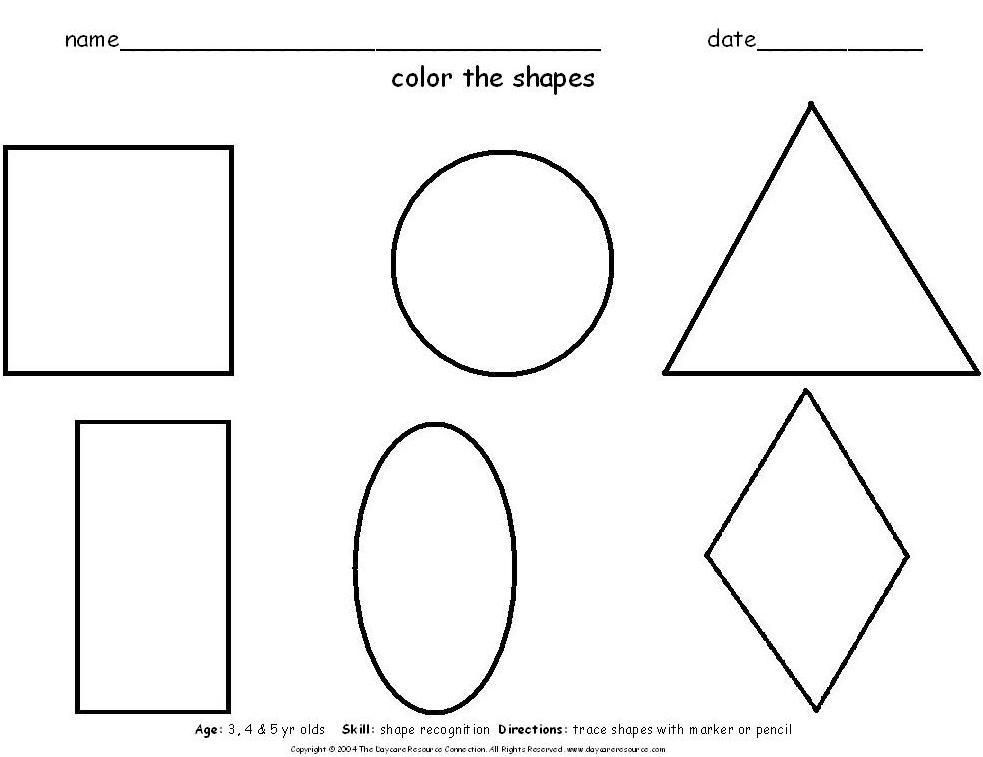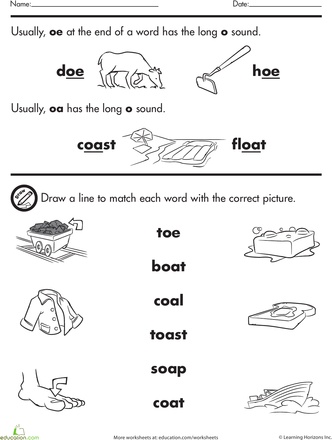Make salt dough
Easy Salt Dough Recipe for Kids (3 Ingredients!)
Jump to RecipeThis simple and easy salt dough recipe is the perfect rainy day activity… Kids will master valuable kitchen skills while learning how to make salt dough, and then spend hours playing with it!
Salt Dough Recipe for Kids
We encourage our kids to get outside and play as much as possible during the summer, but inevitably there’s going to be those rainy days when outside play isn’t an option — like today…
Rather than turning to video games and television for entertainment though, I gathered up my younger three children for a quick kitchen lesson on how to make salt dough. And it actually turned out to be loads of fun AND educational! #momwin
Learning How To Make Salt Dough
While my kids think making and playing with this salt dough recipe is all fun and games, they’re actually learning a whole slew of valuable skills — like brushing up on their math, how to measure solids and liquids, and what happens when you mix certain ingredients. Just to name a few!
RELATED: How To Make Oobleck With Cornstarch and Water
And with only three ingredients — flour, salt, and water — this simple salt dough recipe is the perfect intro to kitchen basics. Luckily, I picked up some inexpensive fresh flour and salt at the grocery store earlier this week in anticipation of a rainy day!
I gave Camden the job of measuring out the flour, showing her how to level it off for a consistent measurement.
Addie measured the salt, again leveling it off using a butter knife.
And I helped Drew measure the water, showing them all how the liquid should be level with the lines on our Pyrex measuring cup.
Then they all took turns mixing the salt dough, and I gave a quick demonstration on how to knead dough. You know they were getting quite antsy to start playing by this point!
They had a blast playing with their salt dough. I gave them a kid-sized rolling pin and some cookie cutters to use. This kept them busy ALL afternoon! These plastic clay tools are super inexpensive and would be fun to play with, as well.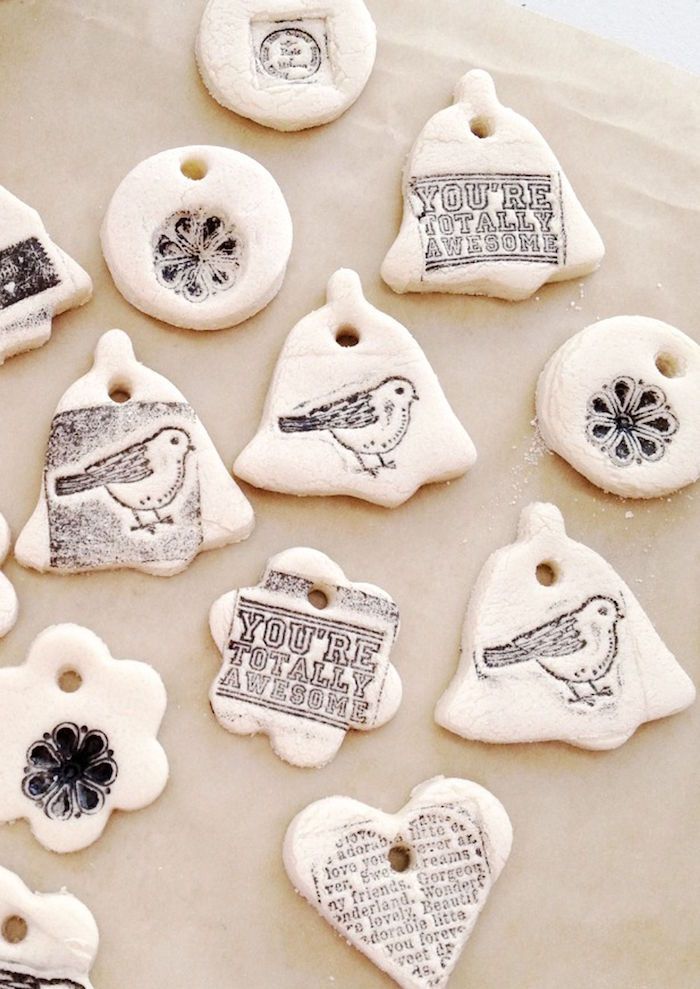
RELATED: 4-Ingredient Glitter Slime Recipe (No Borax!)
Ingredients
- 2 cups all-purpose flour*
- 1 cup salt
- 1 cup water
Instructions
- Combine the flour and salt in a large mixing bowl.
- Gradually add water while stirring and mixing to form a dough with a Play-Doh like consistency.
- Form the dough into a ball and knead for approximately 5-7 minutes, until the dough is smooth and firm. Additional water may be needed, depending upon humidity. Add a teaspoon of water at a time until the dough reaches the proper texture. On the other hand, if the dough is too sticky, add more flour by the teaspoon until it's no longer tacky.
- Store the salt dough in a Ziploc bag when it's not in use to prevent it from drying out.
Notes
I recommend covering your work/play area with an inexpensive plastic tablecloth to make cleanup easier!
How Long To Bake Salt DoughIf you want to bake your salt dough crafts, place them on a foil-covered baking sheet in a 250-degree oven.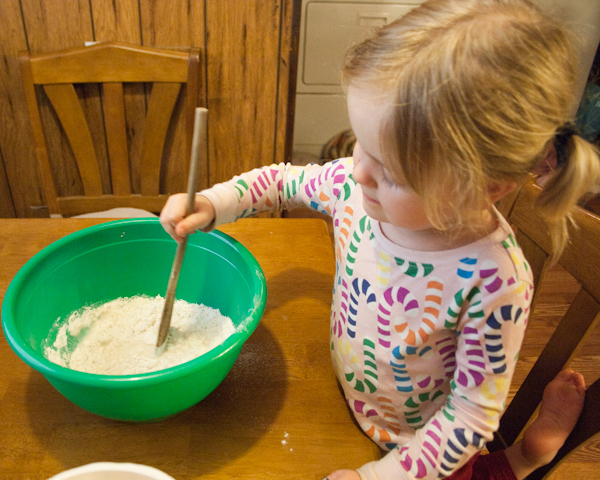 Baking time will vary depending on the size and thickness of your crafts. For each 1/4" in thickness, allow approximately a half hour of baking time, or bake until surface turns light golden brown. Turn each piece frequently so that they dry out evenly. If an area puffs up, poke a hole in it with a pin or toothpick to release the air.
Baking time will vary depending on the size and thickness of your crafts. For each 1/4" in thickness, allow approximately a half hour of baking time, or bake until surface turns light golden brown. Turn each piece frequently so that they dry out evenly. If an area puffs up, poke a hole in it with a pin or toothpick to release the air.
If you or your child has a gluten sensitivity, substituting your favorite gluten-free flour one for one will work well in this recipe.
Recommended Products
As an Amazon.com Services LLC Associates and member of other affiliate programs, I earn from qualifying purchases.
-
Silicone Rolling Pins For Kids (2-pk.)
-
Heavy Duty Plastic Table Cloth
-
Plastic Clay Tools For Kids (10-ct.)
Nutrition Information:
Yield: 1 Serving Size: 2.5 cupsAmount Per Serving: Calories: 0Total Fat: 0gSaturated Fat: 0gTrans Fat: 0gUnsaturated Fat: 0gCholesterol: 0mgSodium: 0mgCarbohydrates: 0gFiber: 0gSugar: 0gProtein: 0g
Important: while salt dough may look good enough to eat, it should not be consumed.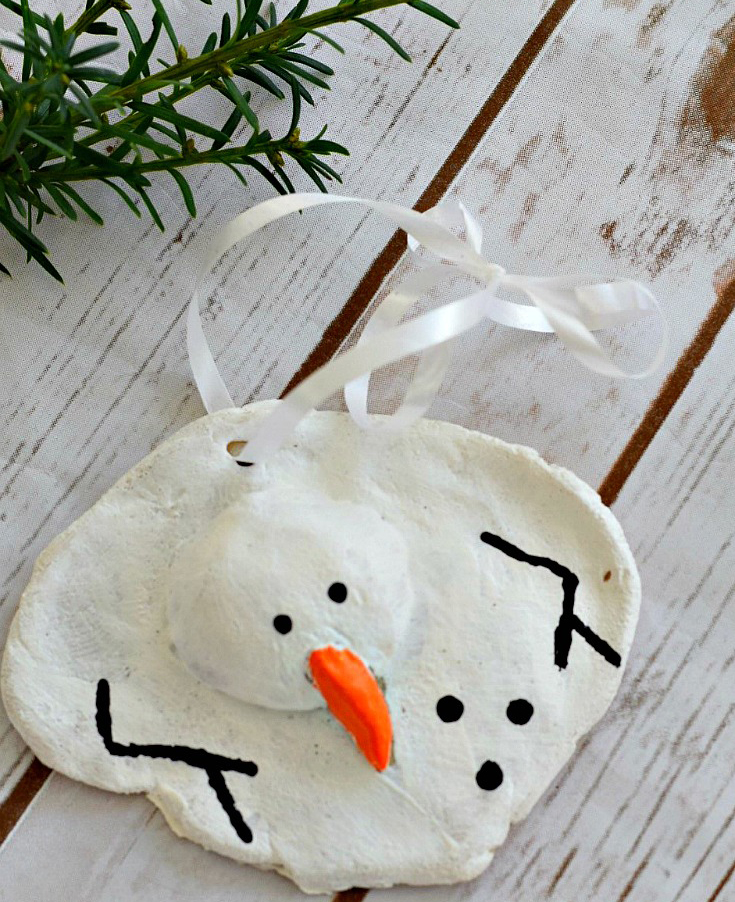 Young children should be supervised while playing with salt dough playdoh.
Young children should be supervised while playing with salt dough playdoh.
No Bake Salt Dough Recipe
You can store salt dough in an airtight container for future use. Or you can let your creations dry and paint them with acrylic paints.
RELATED: DIY Easy Bake Oven Recipes
If you do want to speed up the drying process by baking them, just place your salt dough crafts on a baking sheet and pop them into a 200-degree oven. Baking time will vary based on the size and thickness of your crafts, so just keep a close eye on them.
I’d love to see how your salt dough crafts turn out… Tag me @Unsophisticook on Instagram or use the hashtag #Unsophisticook so I can check them out. Enjoy!
The Best Salt Dough (for Ornaments and Crafting!) to Make with the Kids
Learn how to make classic salt dough with the kids, with baking, painting, and storage info. This method is straight forward, easy, and thorough—and they a perfect kids holiday gift for grandparents, teachers, and loved ones!
Salt Dough
This salt dough is a staple of childhood and I love doing this Christmas activity with my kids each year—and throughout the rest of the year too! We love to make salt dough handprints, ornaments, and sometimes, just any old shape they want to.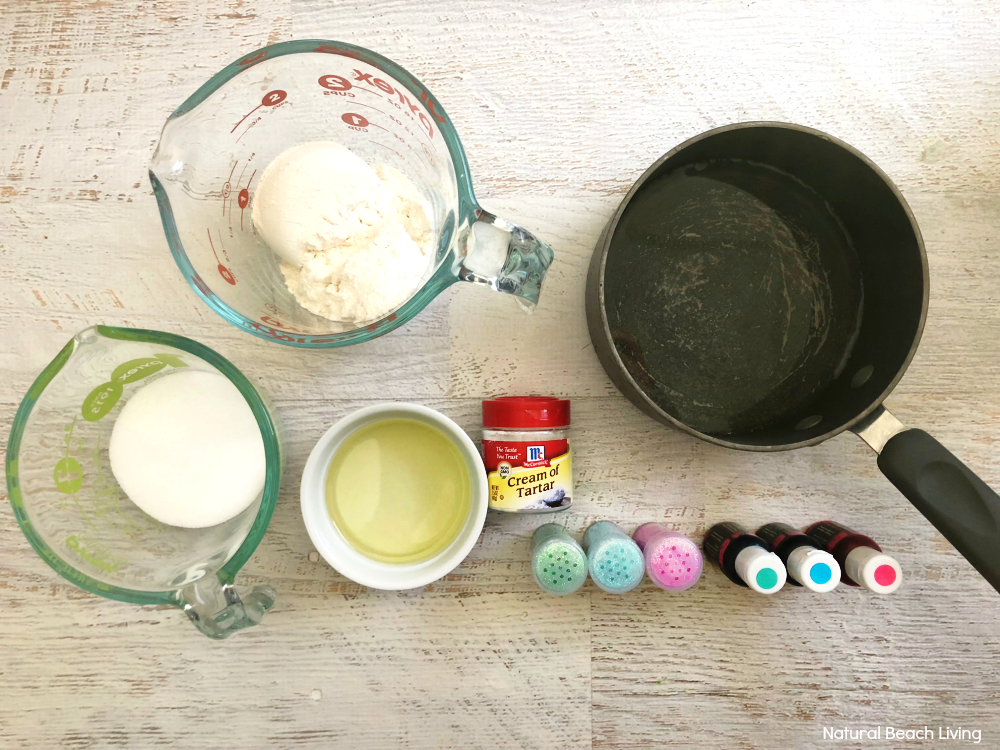 It’s an easy project that we can do together—and then share as kid-made holiday gifts, keepsakes, or house decorations.
It’s an easy project that we can do together—and then share as kid-made holiday gifts, keepsakes, or house decorations.
Salt Dough Recipe
Making salt dough at home is as easy as combining three pantry staples together into a dough. It’s fairly fool proof (as long as you follow the measurements!) and is a recipe that even little kids can help make.
Ingredients in Salt Dough
To make this recipe, you’ll need:
- table salt
- all-purpose flour
- water
TIP: That’s it! (I buy store brand, cheap flour for this since project to keep it very budget-friendly.)
How to Make Salt Dough Ornaments Step-by-Step
Here’s a look at how to make the dough for this salt dough. Scroll down to the bottom of the post for the full information.
- Measure out the flour and water. (photo 1)
- Add the water. (photo 2)
- Stir with a wooden spoon. (photo 3)
- Keep stirring until the dough is mostly together and is hard to stir any longer.
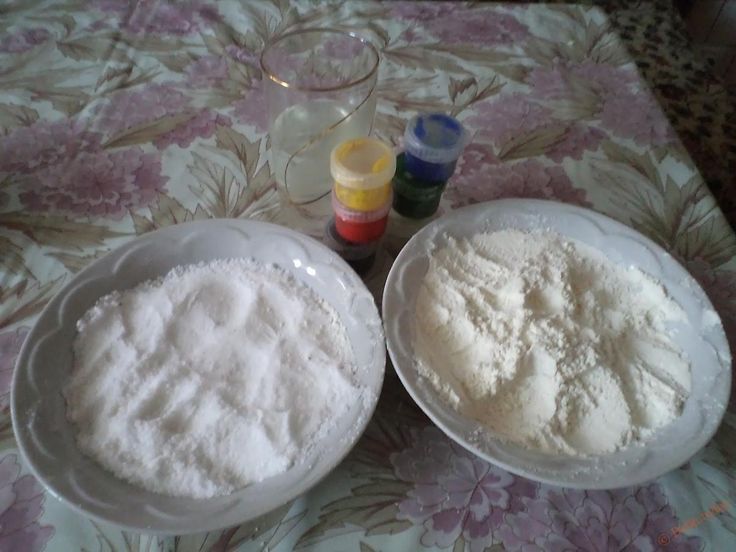 (photo 4)
(photo 4) - Knead a few times with hands to bring the dough together. (photo 5)
- Place dough between two pieces of parchment paper and roll out. (photo 6)
TIP: You can divide the dough in sections so multiple kids can have their own dough to work with.
How to Cut Out, Bake and Decorate Salt Dough Ornaments
Once you start rolling, here’s a look at what will follow if you want to make these into ornaments. (Skip the hole poking if you want to just make these as shapes for the kids to paint.)
- Roll out, changing directions occasionally, until about 1/4-inch thick. (This may not get precise if you’re working with kids and that’s okay!) (photo 1)
- Stamp cookie cutters. (photo 2)
- Remove the dough around the shapes, then either transfer the whole piece of parchment paper to a cookie sheet OR transfer just the shapes to a parchment-lined cookie sheet. (photo 3)
- Poke holes so you have a place for a string to hang as ornaments.
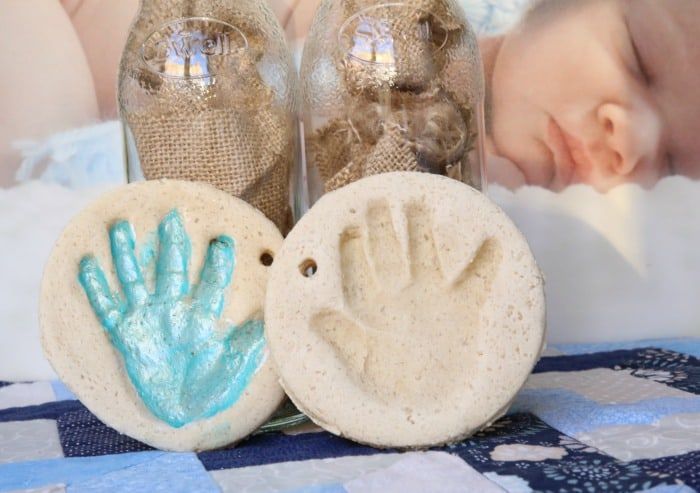 (photo 4)
(photo 4) - Press in a hand to make a handprint, if desired. (photo 5)
- Bake, let cool and decorate! (photo 6)
TIP: Re-roll any remaining dough after Step 3 here to make additional ornaments.
Salt Dough Handprint Ornament
Capturing a handprint in salt dough is a perfect grandparent gift, or a keepsake ornament to make for your own tree. I love pulling out our little collection year after year. Know that getting a good print may take a few tries if doing a baby’s hand!
TIP: Check the size of your round cookie cutter against your child’s hand to make sure that it’s big enough. You may need one that’s 4-5 inches in diameter.
Best Paint for Salt Dough Ornaments
If the kids are wearing smocks, the table is protected, and you are reasonably sure they won’t paint all over their hands and faces, I like using regular acrylic craft paint since it holds up best on crafts. With younger kids who may wind up wearing more of the paint, I’d recommend tempura washable paints.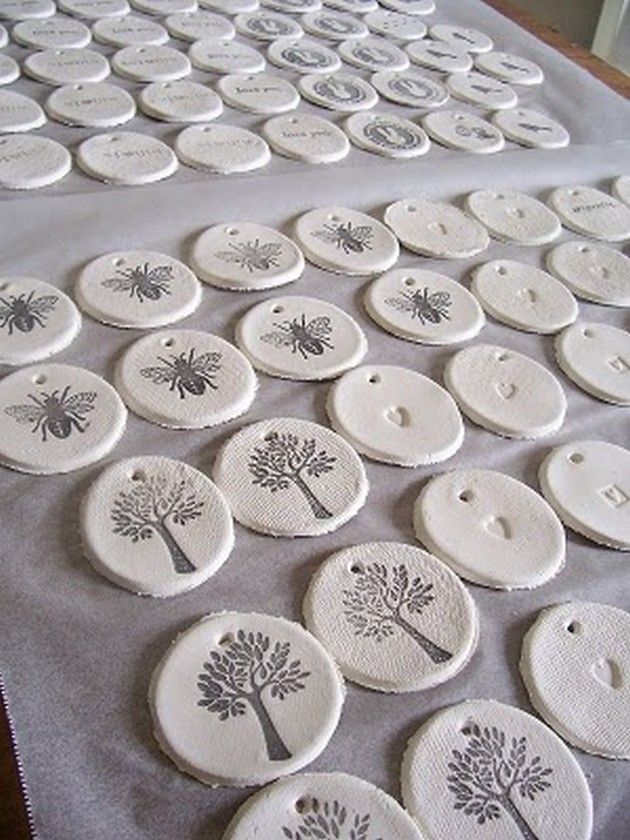
TIP: We put our paint into the base of old egg cartons since we always have those on hand. You can also use paper plates.
How to Preserve Salt Dough Ornaments
To help preserve your finished dried ornaments, you can coat with a layer or two of Mod Podge or spray with a sealer. Either work well. I’d recommend coating or sealing both sides, so do one side and let it dry, and then do the second side. If using the sealer, do it in a well ventilated area without the kids too close by.
TIP: To store these ornaments from year to year, you’ll want to wrap in bubble wrap. Store in a container that won’t be banged around, dropped or exposed to excess moisture.
Why is my salt dough puffing up?
If you mistakenly use self-rising flour, they may puff. And sometimes it happens randomly. Keep the oven temperature low and if it happens consistently, you can try baking at an even lower temperature for a slightly longer amount of time.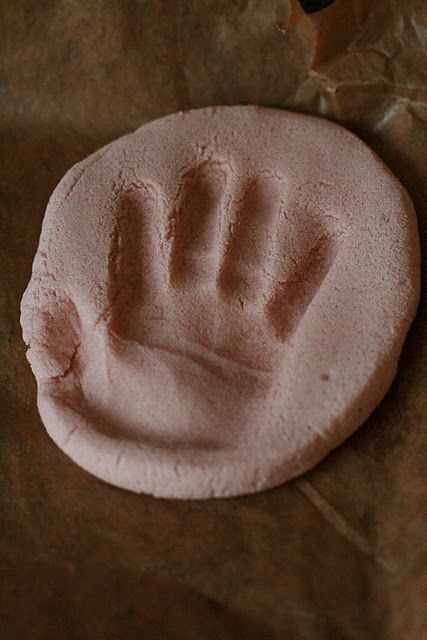
Tips for Making the Best Salt Dough Ornaments
- If the dough is too wet and sticky, knead in a little more flour. If it’s too stiff, add a little more water. There is a big range in the way different flours absorb liquid, so there is a normal range of variation in liquid needs. It should be easy to work with—soft and not too stiff and not excessively sticky.
- Use paper lollipop sticks or a skewer to make your holes.
- Use a 4-5 inch round cookie cutter to make handprint ornaments.
- Tie on baker’s twine or thin ribbon to hang as ornaments.
- Try to get the dough to an even thickness before baking so the ornaments bake evenly.
- Bake for the time indicated and then longer if your ornaments still feel soft. They should be firm to the touch without much give.
- Let cool fully before painting.
- If you want to paint the background of a handprint ornament, do that before you paint the inside of the hand.
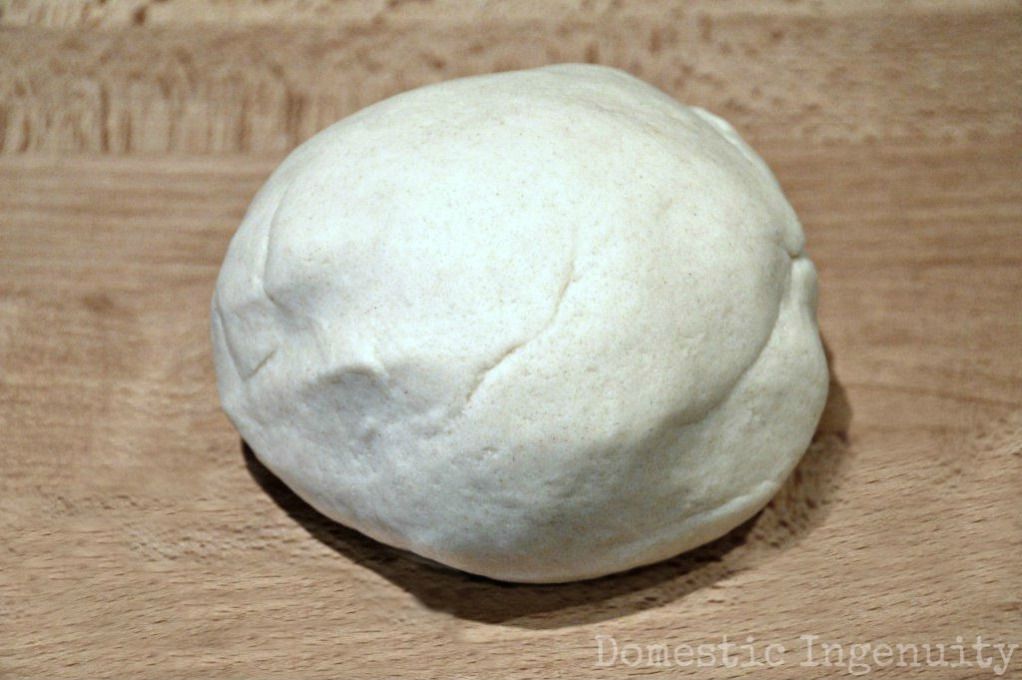 Let dry before adding a second color. Some people like to paint the whole thing white or cream to give it a more finished look.
Let dry before adding a second color. Some people like to paint the whole thing white or cream to give it a more finished look. - Use acrylic craft paint for older kids who can be trusted with paint and tempura washable paints with younger toddlers.since it holds up best on crafts. With younger kids who may wind up wearing more of the paint, I’d recommend.
- To help preserve your finished dried ornaments, you can coat with a layer or two of Mod Podge or spray with a sealer.
I’d love to hear your feedback on this project and what your kids thought of it, so please comment below to share!
Prep Time 30 minutes
Cook Time 2 hours
Total Time 2 hours 30 minutes
Author Amy Palanjian
Cuisine American
Course Holiday
Calories 1kcal
Servings 2 dozen ornaments
- ▢ 4 cups flour
- ▢ 1 cup table salt
- ▢ 1.5 cups water
Mix the ingredients together in a large bowl using a wooden spoon.
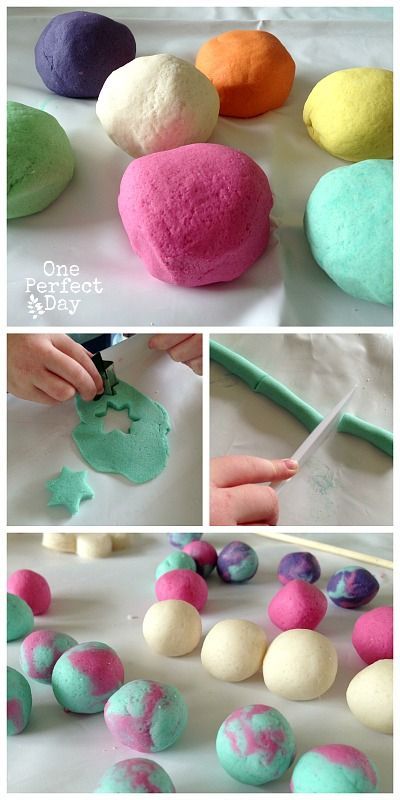 When it becomes too stiff to stir, use clean hands to bring the dough together.
When it becomes too stiff to stir, use clean hands to bring the dough together.NOTE: If the dough is too wet and sticky, knead in a little more flour, about 1 tablespoon at a time. If it's too stiff, add a little more water, about 1 tablespoon at a time. There is a big range in the way different flours absorb liquid, so there is a normal range of variation here. It should be easy to work with—soft and not too stiff and not excessively sticky.
Knead a few times until the dough is uniform and soft, about 3-5 minutes.
Divide dough into 2 or 4 sections and roll out to about 1/4-½ inch thick between two sheets of parchment paper. This will help prevent sticking.
Cut out with cookie cutters. Transfer shapes to a parchment-lined baking sheet.
Repeat rolling and cutting out shapes to use up the dough.
Preheat oven to 250 degrees F.
Do a 4-5-inch circle and press in a child's handprint if desired.
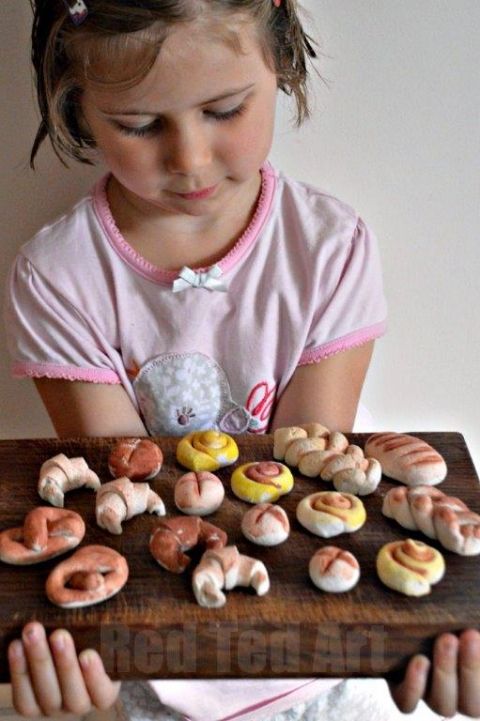
Use a paper lollipop stick or a skewer to make a hole to hang as an ornament.
If making ornaments, bake for 90 minutes to 2 hours; if baking handprints, bake for 2-3 hours. Continue baking both ornaments and handprints as needed until they are until just firm to the touch, checking every 20 minutes. (It's not a problem if yours take longer than the initial baking time—it varies based on thickness and size...which will likely vary if you are baking these with kids!) They do not need to be rock hard, but should not feel squishy. Handprints will likely take longer than smaller ornaments and may take closer to 4 hours.
Remove from oven, let cool, and paint if desired with acrylic or washable tempera paint.
Once paint is completely dry, seal with Mod Podge if desired.
Mixing Bowl
parchment paper
Mini Cookie Cutters
- Divide the recipe in half to make a smaller portion of dough if desired.
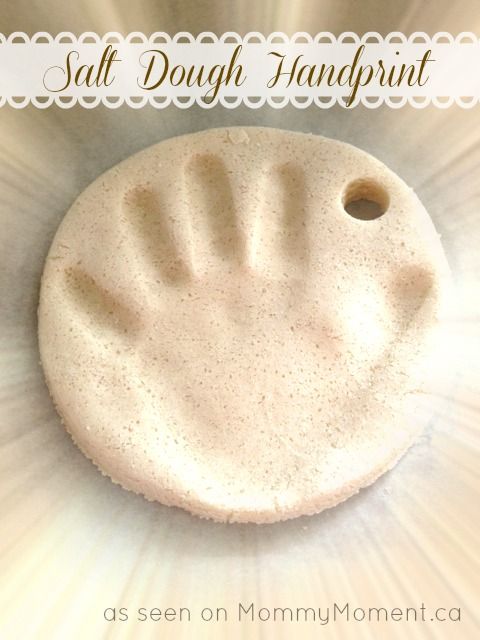
- Use paper lollipop sticks or a skewer to make your holes.
- Use a 4-5 inch round cookie cutter to make handprint ornaments.
- Tie on baker's twine or thin ribbon to hang as ornaments.
- Try to get the dough to an even thickness before baking so the ornaments bake evenly.
- Bake for the time indicated and then longer if your ornaments still feel soft. They should be firm to the touch without much give but do not need to be rock hard. It is not a sign of a problem if yours take longer than mine did to bake—flours and ovens vary!
- Let cool fully before painting.
- If you want to paint the background of a handprint ornament, do that before you paint the inside of the hand. Let dry before adding a second color.
- Use regular acrylic paint for older kids who can be trusted with paint and washable tempera paint with younger toddlers.
- To help preserve your finished dried ornaments, you can coat with a layer or two of Mod Podge or spray with a sealer.
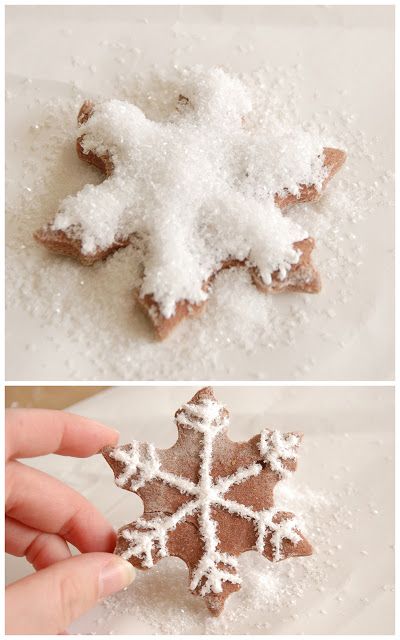
Calories: 1kcal, Fat: 1g, Saturated Fat: 1g, Polyunsaturated Fat: 1g, Monounsaturated Fat: 1g, Fiber: 3g, Sugar: 1g, Calcium: 31mg, Iron: 6mg
Tried this recipe?Rate in the comments and tag @yummytoddlerfood on IG!
Salt dough for children
Wheat flour 1 tbsp Salt (fine) 1 tbsp Water is cold 0.5 - 1 tbsp Food coloring 3 - 5 ml.
Salt dough can be stored in the refrigerator for a long time. Our dough is ready for new masterpieces! Sip with pleasure!
Colored salt dough made from natural dyes
Children often taste different objects while exploring the world around them. This can happen with salt dough too. If you are making a craft with a small child who still puts everything in his mouth, then we recommend using natural food coloring so as not to worry.
Ingredients:
- Flour (highest grade) - 150 gr.
- Cold water - 100 gr.
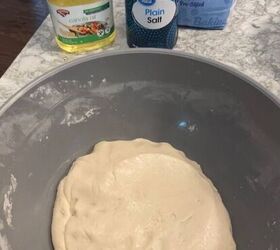
- Salt (not iodized and crushed) - 150 gr.
For natural dyes:
- Turmeric (yellow) - 3 tsp.
- Raw beetroot juice (pink) - 3 tsp.
- Cocoa (brown) - 3 tsp.
- Flour (thickener for beetroot juice) - 2.5 tsp.
- Salt (thickener for beetroot juice) - 1.5 tsp.
Cooking method:
Step 1. Weigh and pour out the required amount of flour and salt.
Step 2. Salt is dissolved in water to the maximum. If all the salt has not completely disappeared, then this is not a problem.
Step 3. Pour the flour into the already salted water.
Step 4. Thoroughly stir the flour to remove any lumps. It is best to use a wooden spoon.
Step 5. Knead the dough on a clean table. You should get a mass that will not stick to your hands.
Step 6. Now color the finished dough. We divide the lump into 4 equal parts. We leave one lump of the original color.
Step 7.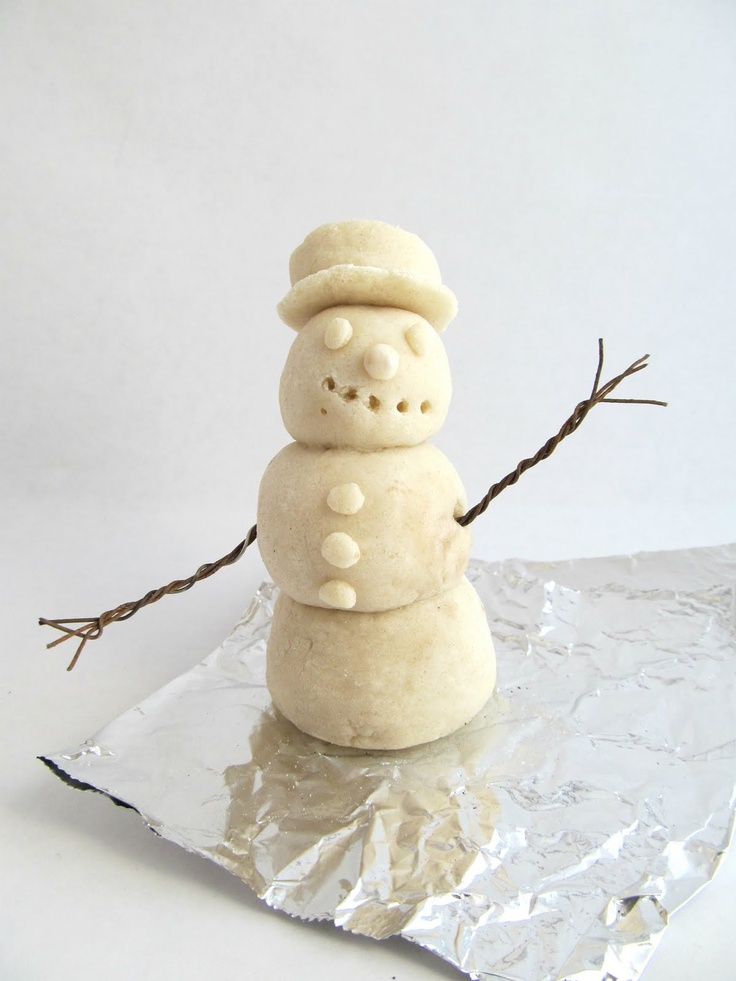 To create a pink dough, peel the beets and pass them through a fine grater, squeeze out the juice. Mix vegetable juice with 1.5 tsp. salt and 2.5 tsp. flour. Mix well and get a thick mass of bright color. Then we roll out the already prepared white ball a little and place the pink mass in the middle. We collect the edges and roll out the dough between the palms, crushing a little, until the bright paint disperses. When everything is ready, place the ball in a box with a screw cap so that the surface does not become crusty while the rest of the dyes are being made.
To create a pink dough, peel the beets and pass them through a fine grater, squeeze out the juice. Mix vegetable juice with 1.5 tsp. salt and 2.5 tsp. flour. Mix well and get a thick mass of bright color. Then we roll out the already prepared white ball a little and place the pink mass in the middle. We collect the edges and roll out the dough between the palms, crushing a little, until the bright paint disperses. When everything is ready, place the ball in a box with a screw cap so that the surface does not become crusty while the rest of the dyes are being made.
Tip: since the beetroot juice stains, it's best to use gloves to avoid getting dirty.
Step 8. We make yellow dough. Add 5 tsp to the required amount of turmeric. water and mix. After you get a thick mass, repeat the steps that were performed to create a pink dough.
Step 9. To get a natural brown dye, mix 4 tsp. water with cocoa and again repeat the already familiar steps.
Step 10.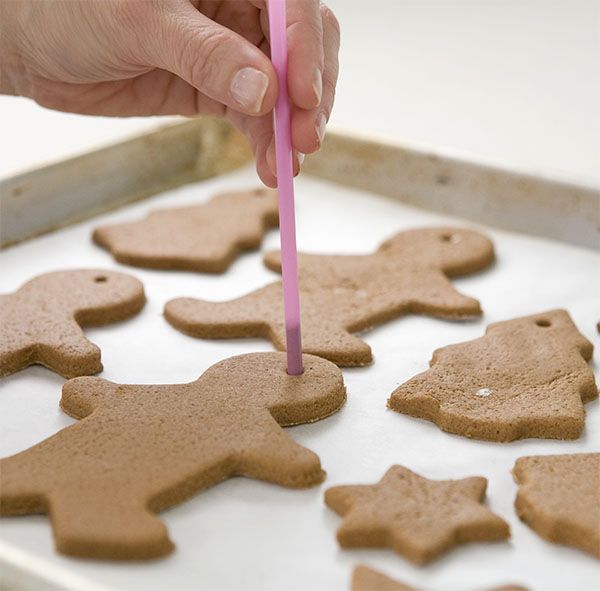 Store in a plastic bag or container with a lid in the refrigerator. We got 4 lumps of dough in different colors: white, yellow, brown and pink. Create new and interesting crafts for the joy of the whole family!
Store in a plastic bag or container with a lid in the refrigerator. We got 4 lumps of dough in different colors: white, yellow, brown and pink. Create new and interesting crafts for the joy of the whole family!
Salt dough for modeling at home
Making salt dough at home is quite simple and does not take long. The composition of this recipe includes only natural ingredients, so the "plasticine" is absolutely harmless and will suit even the smallest children. Thanks to vegetable oil, salt dough will not stick to your hands and dry out during use.
Ingredients:
- Salt - 200 gr.
- Flour - 400 gr.
- Water - 200 ml.
- Vegetable oil - 60 ml.
Method of preparation:
Step 1. We prepare all the necessary ingredients for the dough.
Step 2. Pour salt and flour into a clean deep dish. We mix everything well.
Step 3. Pour water to salt and flour, stir thoroughly so that the mass is without lumps.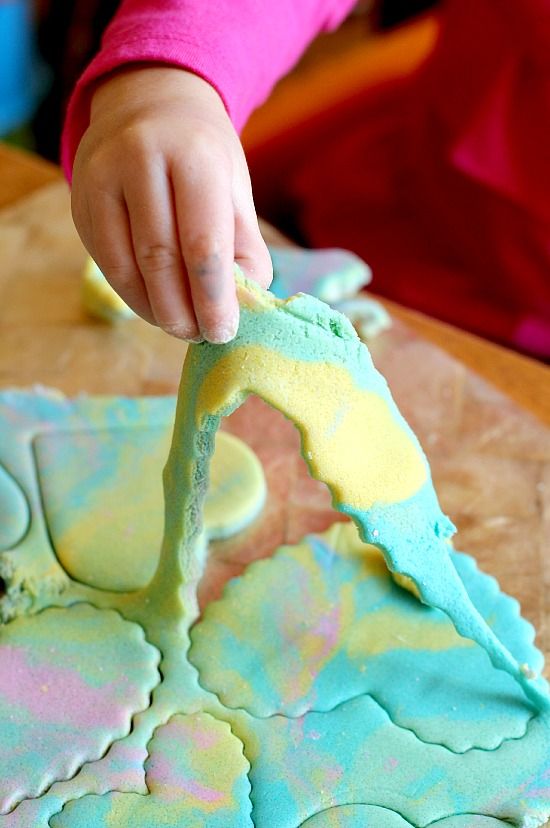
Step 4. Add vegetable oil and mix everything again until the dough becomes elastic.
Tip: If small lumps of dough separate during kneading,
add a little water. If it sticks to your hands, add flour.
Step 5. Make a ball out of the dough and knead it in your hands. As soon as the ball stops spreading and keeps its shape, the dough is ready.
Eco-friendly molding material is ready! Realize your most interesting ideas with your child! Good luck with your crafts!
Salt dough recipe with wallpaper paste
This salt dough recipe is not entirely natural, as it contains wallpaper paste. Thanks to him, the mixture sets and dries faster. Such material can be safely stored in the refrigerator in an airtight package for about 2 weeks, and it will not lose its properties. If you are making a craft with young children, then it is better to choose a salt dough recipe made from natural ingredients to avoid unpredictable situations.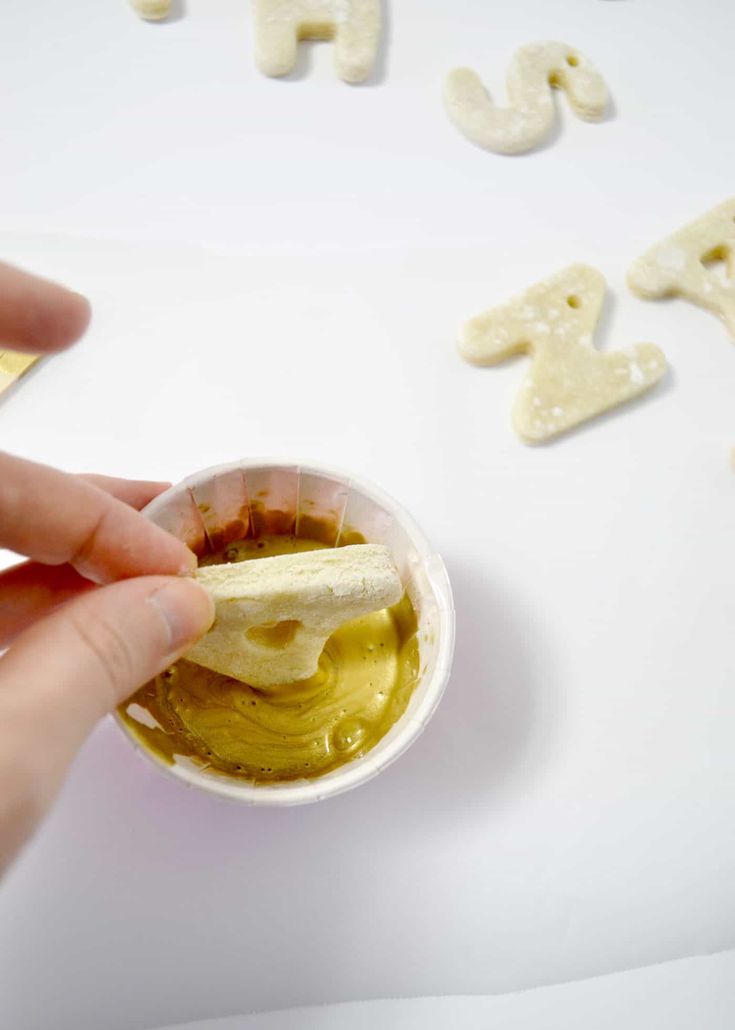
Ingredients:
- Salt - 200 gr.
- Flour - 200 gr.
- Water - 125 gr.
- Wallpaper paste - 1 tbsp.
- Vegetable oil - 1 tbsp.
Preparation:
Step1 . Getting ready for work. We measure the right amount of flour, salt and water, using a measuring cup.
Step 2. Mix salt, flour, water and glue. If the dough is too liquid, then add a little more salt and flour until the mixture becomes dense.
Step 3. Knead the dough with your hands until it becomes elastic and loses its stickiness.
Step 4. When the mass reaches the desired consistency, wrap it in a plastic bag (you can use a plastic container with a lid) and send it to the refrigerator for 30 minutes.
Step 5. Now you can get the salt dough and start sculpting! Good luck!
Homemade Salt Dough Play Doh
Today there are many variations of salt dough available in any store. The most popular "plasticine" among modern children is Play Doh.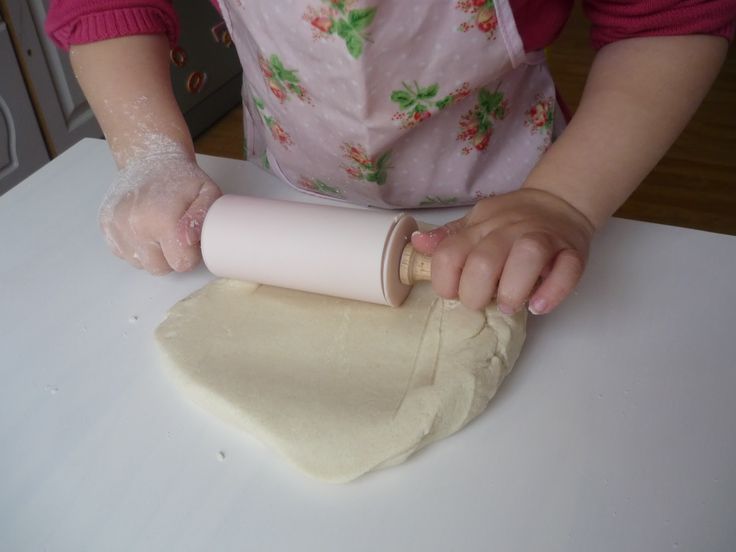 Our recipe will help you save money on a new toy for your child, while not depriving him of modeling material. Citric acid, which is part of the test, is absolutely safe for the palms, and glycerin will give crafts an unusual glow.
Our recipe will help you save money on a new toy for your child, while not depriving him of modeling material. Citric acid, which is part of the test, is absolutely safe for the palms, and glycerin will give crafts an unusual glow.
Ingredients:
- Salt - 0.5 tbsp.
- Flour - 1 tbsp.
- Water - 0.5 tbsp.
- Vegetable oil - 1 tbsp.
- Dyes.
- Glycerin - 1 tsp.
Method of preparation:
Step 1. Take a saucepan or saucepan and mix all the ingredients necessary for the dough there.
Step 2. Put the container on medium heat.
Step 3. Pour water into the pot one spoon at a time, stirring constantly.
Step 4. Cook the dough for about 5 minutes until it becomes homogeneous and translucent.
Step 5. Add dyes.
Tip: if you want the whole dough to be the same color, then add
one dye to the whole mass. If several colors are needed, then divide the
dough into the required number of parts and add a dye of a different color to each.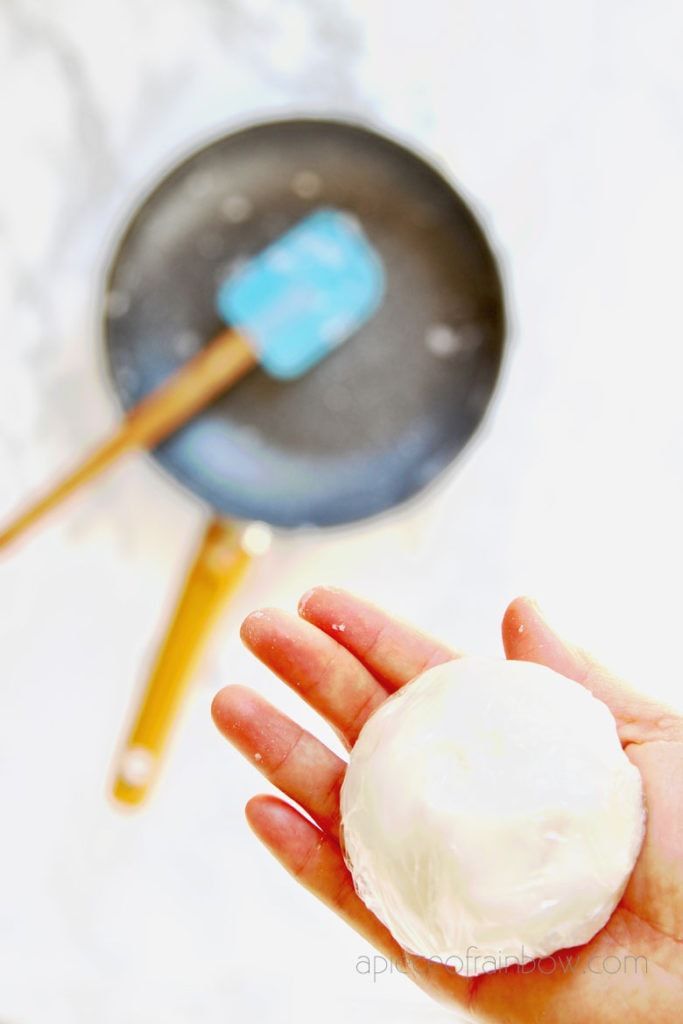
Step 6. Remove the dough from the pan and place it on a board lightly dusted with flour.
Step 7. Knead until the material is homogeneous.
The dough turns out beautiful, elastic and soft, which allows you to create even the most unusual crafts!
Chemical composition
| Nutrient | Quantity | Norm | % of norm in 100 g | % Per Serving |
|---|---|---|---|---|
| Vitamin A | 0 | 900 mcg | 0 | 0 |
| Vitamin B1 | 0 mg | 1.5 mg | 3. 8 8 | 2.8 |
| Vitamin B2 | 0 mg | 1.8 mg | 0.8 | 0.6 |
| Vitamin B4 | 13 mg | 500 mg | 3.5 | 2.6 |
| Vitamin B5 | 0.1 mg | 5 mg | 2 | 1.5 |
| Vitamin B6 | 0 mg | 2 mg | 2.9 | 2.1 |
| Vitamin B9 | 6.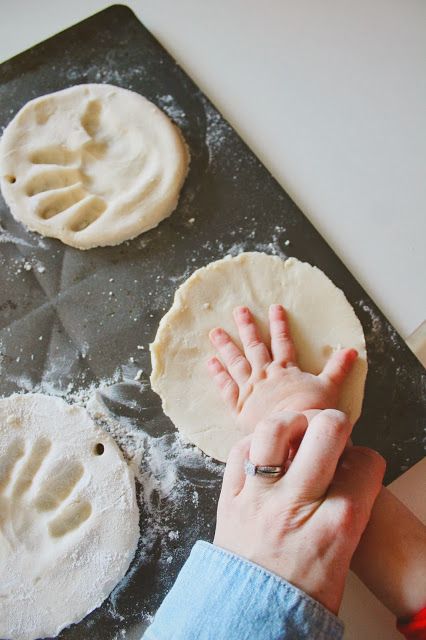 8 mcg 8 mcg | 400 mcg | 2.3 | 1.7 |
| Vitamin B12 | 0 | 3 mcg | 0 | 0 |
| Vitamin C | 0 | 90 mcg | 0 | 0 |
| Vitamin D | 0 | 10 mcg | 0 | 0 |
| Vitamin E | 0.4 mg | 15 mg | 3.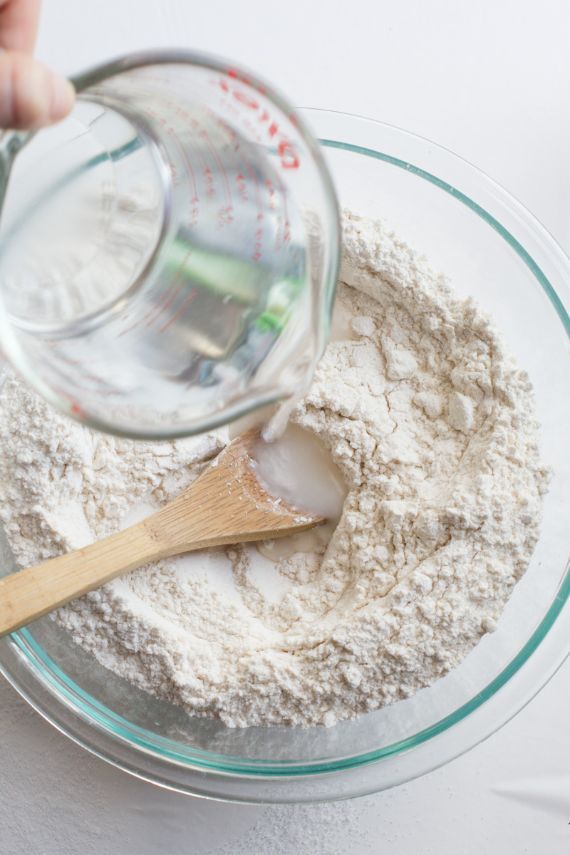 4 4 | 2.5 |
| Biotin | 0.5 mg | 50 mg | 1.4 | 1 |
| Vitamin K | 0 | 120 mcg | 0 | 0 |
| Vitamin PP | 0.7 mg | 20 mg | 4.9 | 3.6 |
| Potassium | 33.2 mg | 2500 mg | 1.8 | 1.3 |
| Calcium | 115.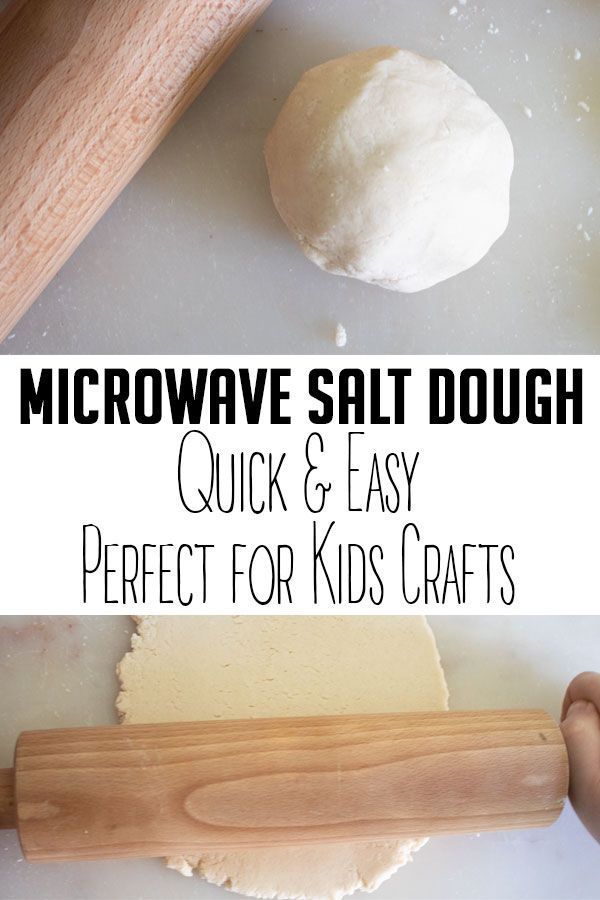 4 mg 4 mg | 1000 mg | 15.6 | 11.5 |
| Silicon | 1 mg | 30 mg | 4.5 | 3.3 |
| Magnesium | 10.8 mg | 400 mg | 3.6 | 2.7 |
| Sodium | 11614.5 mg | 1300 mg | 1207.3 | 893.4 |
| Sulfur | 71.5 mg | 500 mg | 19.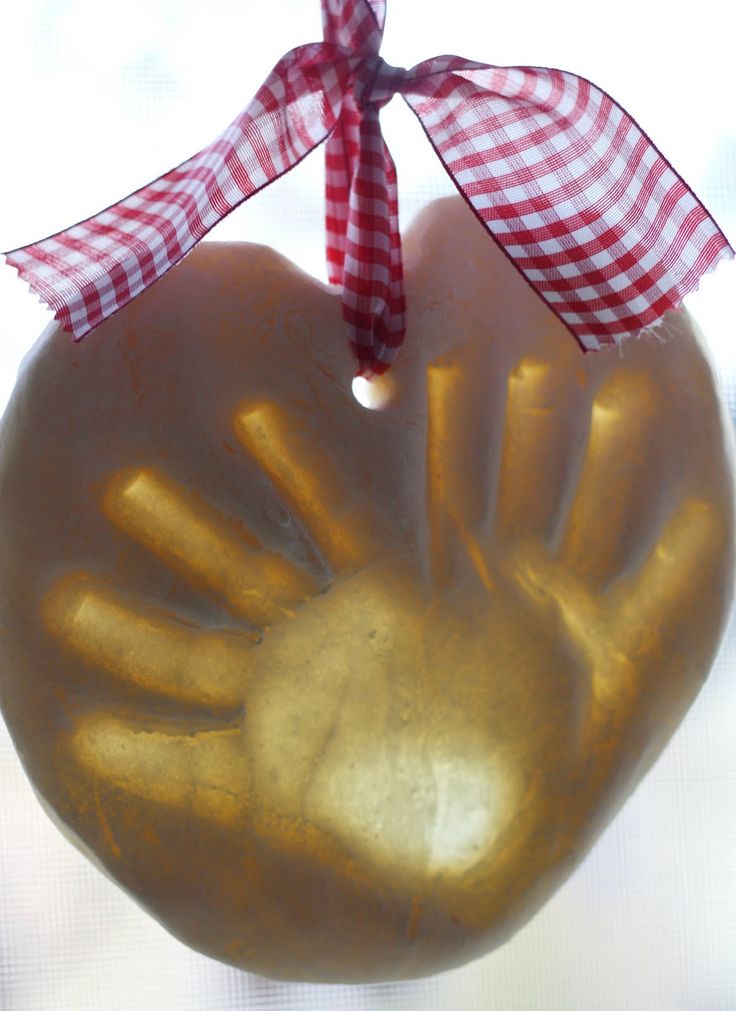 3 3 | 14.3 |
| Phosphorus | 44 mg | 800 mg | 7.4 | 5.5 |
| Chlorine | 17912 mg | 2300 mg | 1052.4 | 778.8 |
| Aluminum | 0 | 30 mcg | 0 | 0 |
| Iron | 1.2 mg | 18 mg | 8.8 | 6.5 |
| Iodine | 0.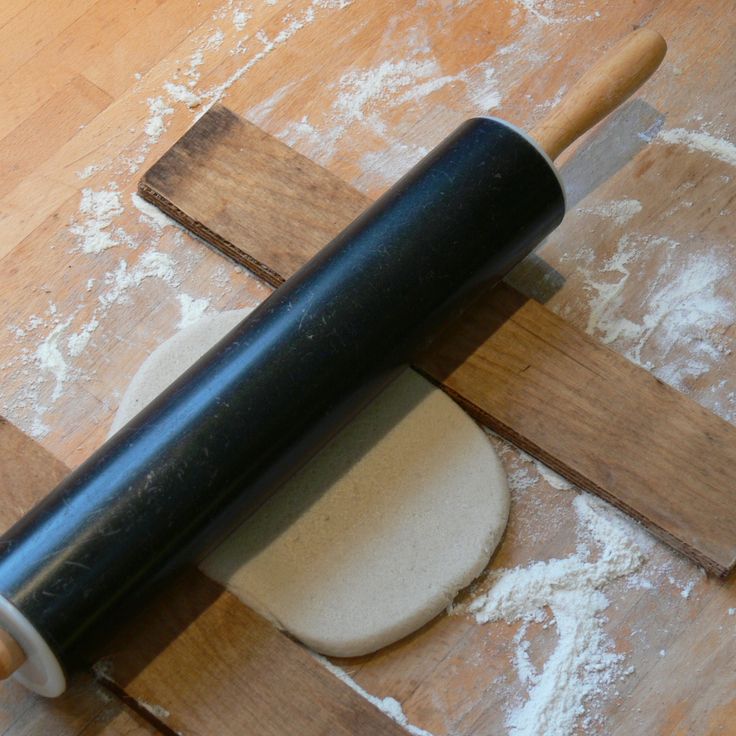 4 mcg 4 mcg | 150 mcg | 0.3 | 0.3 |
| Cobalt | 4.9 mcg | 10 mcg | 66.2 | 49 |
| Lithium | 0 | 70 mcg | 0 | 0 |
| Manganese | 0.2 mcg | 2 mcg | 14.7 | 10.9 |
| Copper | 108.1 mcg | 1000 mcg | 14. 6 6 | 10.8 |
| Nickel | 0.6 mcg | 200 mcg | 0.4 | 0.3 |
| Rubidium | 0 | 2 mcg | 0 | 0 |
| Selenium | 1.5 mcg | 55 mcg | 3.8 | 2.8 |
| Fluorine | 18.9 mcg | 4000 mcg | 0.6 | 0.5 |
| Chrome | 0.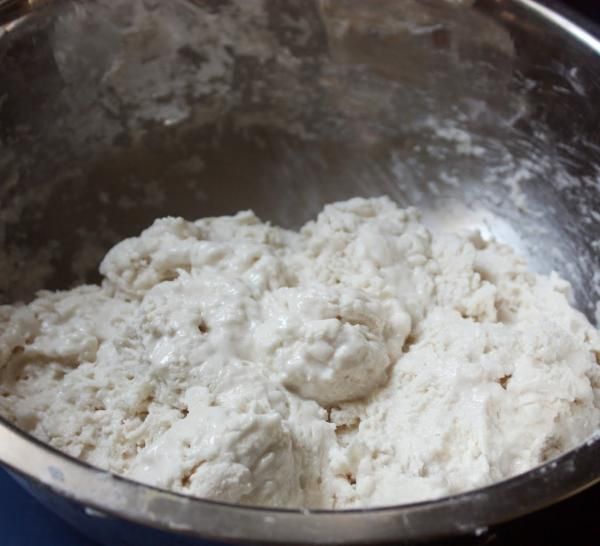 6 mcg 6 mcg | 50 mcg | 1.5 | 1.1 |
| Zinc | 0.4 mg | 12 mg | 4 | 3 |
| Boron | 9.3 mcg | 1.2 mcg | 1041.7 | 770.8 |
| Vanadium | 22.5 mcg | 20 mcg | 152 | 112.5 |
| Molybdenum | 36.1 mcg | 70 mcg | 69.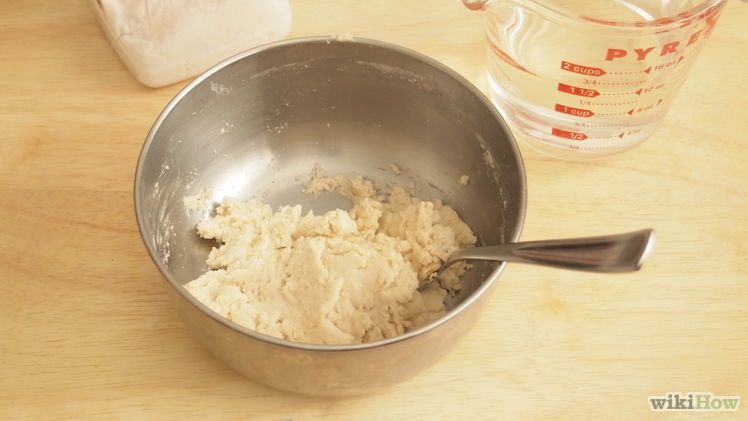 7 7 | 51.6 |
The perfect salt dough recipe. Tips for beginners
I'm here: home ›
Creativity
›
Crafts
›
Plasticine
› The perfect salt dough recipe. Beginner Tips
From plasticine
A real miracle when a shapeless plastic mass turns into a playful kitten or a fabulous house. I suggest you feel like a magician and prepare the perfect salty dough for future masterpieces.
1233 t.0
Weight, which keeps its shape perfectly floats and does not deteriorate over time, - dream of all lovers modeling. And the dream of all parents - safe plastic mixture without allergens and harmful additives .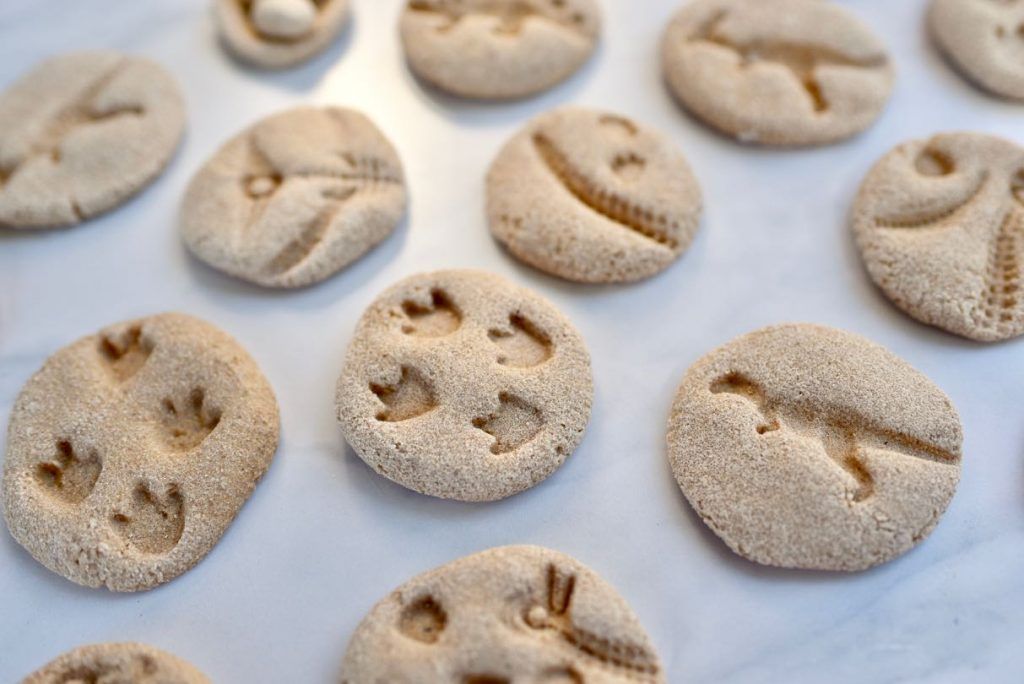 Salt dough skillfully brings everything together these qualities and thanks to baking better preserved than plasticine.
Salt dough skillfully brings everything together these qualities and thanks to baking better preserved than plasticine.
figurine from salt dough will become an exquisite decoration of your rooms and a wonderful tool for games. How to make salt dough soft and pliable, and even for a long time to keep flour mixture? Desert Boy Knows answer!
Classic salt dough recipe
modeling from salt dough is not a new occupation. The origins of this type of creativity are lost deep in the history of our culture. Remember only Kolobok from a folk tale and the custom of baking larks on Candlemas. Hold the basic salt dough recipe for crafts - continue traditions of ancestors with pleasure!
For making salt dough for you will need:
- 1 glass of fine salt
- 2 cups of flour
- half a glass water,
- 5 Art. l. sunflower oil,
- natural juice or gouache (optional).
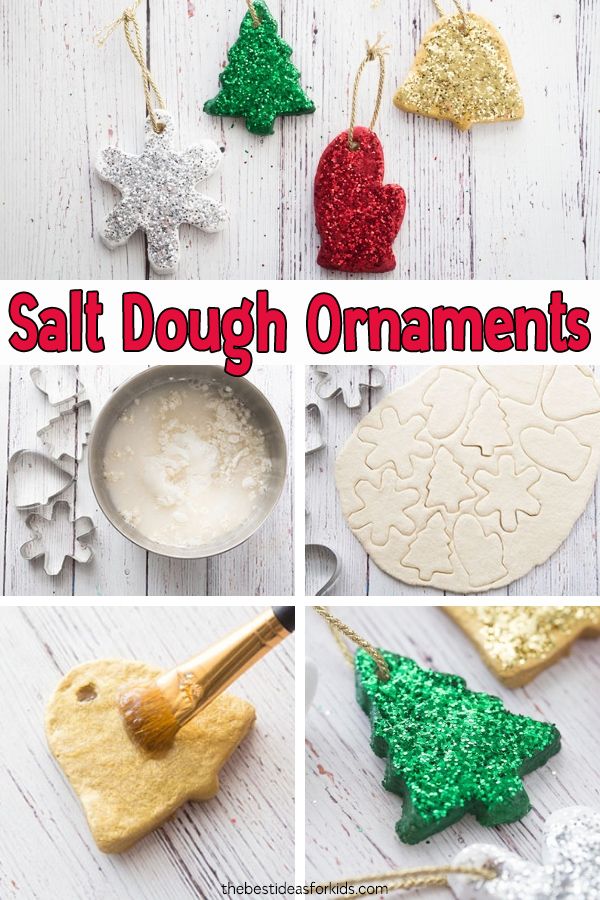
K cause!
AT In a deep bowl, mix dry ingredients: salt and flour. Add sunflower oil and pour some water. Knead the dough. To give the mixture a certain color, carefully stir in the carrot (beetroot) juice or diluted in water gouache. If necessary, small add water or flour in portions to adjust the viscosity of the dough.
Important! It is best to store the finished dough in refrigerator no more than a day, tightly wrapping the mass with cling film.
Salt dough recipe for sophisticated works
If a you plan to make thin embossed figurines or miniatures salt dough, to the classic recipe you have to add a secret ingredient. Which? Read on - I'll tell you everything!
For making salt dough in a special way the recipe you will need:
- 1.5 cups of flour
- 1 a glass of salt
- 125 ml of water
- 1 Art.
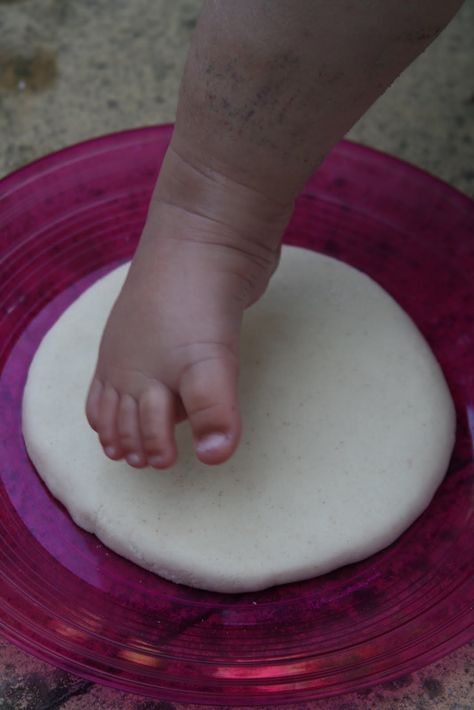 l. PVA glue or starch
l. PVA glue or starch - food dye.
K cause!
Prepare deep container. Mix flour and salt and add 125 ml of water. Mix thoroughly Ingredients. Now add a dining room a spoonful of starch or PVA glue. Starch increases the plasticity of the mass, and the glue increases its strength. PVA can be replaced 2 tsp wallpaper glue diluted in water, according to instructions. At the end add food coloring and mix well. If you need a lot of different colors, divide the dough into several pieces and add the colors you want. Merry creativity!
Preparing tools for working with salt test
From salt dough can be made that anything - toy products, animals, flowers and luxurious paintings. But so that your the work looked original and intricate, you will need different tools. You don't need to buy anything, use items that are at hand.
For creating unique patterns on the surface salt dough is ideal:
- curly rolling pin or water bottle
- toothpicks (for punching holes)
- caps from markers,
- rod from a ballpoint pen
- knife for plasticine,
- molds for cookies,
- buttons,
- beads,
- pasta,
- lace and other stamps for embossing,
- press for garlic.
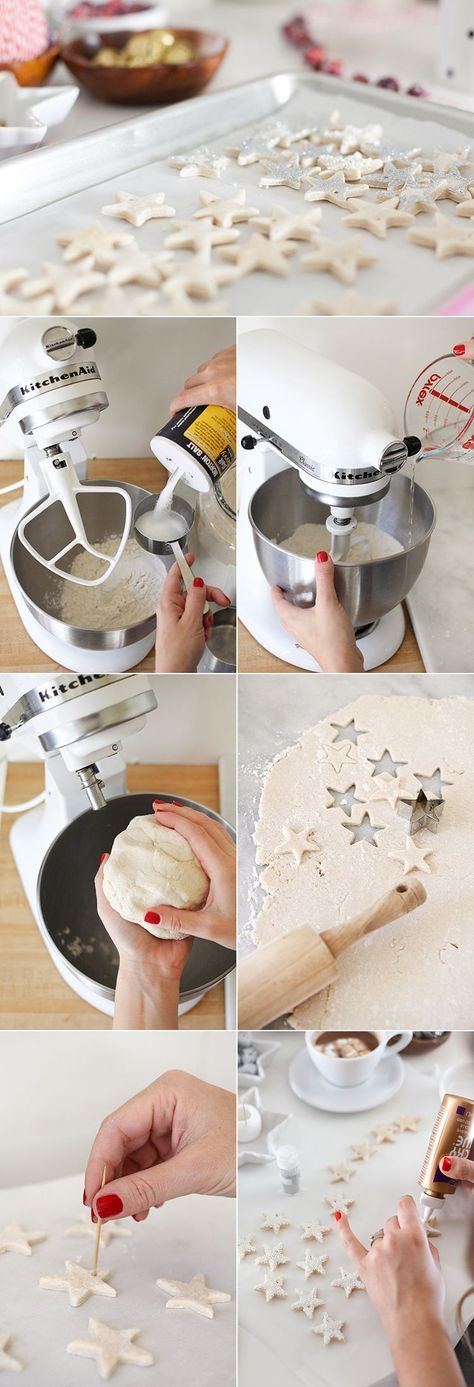
Boldly Experiment with patterns and shapes! AT in case of failure, the item is easy to fix or blind again.
How to dry products from salty test?
To the finished craft pleased the eyes for a long time your guests, it needs to be right dry. Remember: the main rule of drying salt dough products - no sudden changes in temperature.
There are two ways to dry figurines from salt dough:
1. The simplest is natural. Just leave the figurine to dry room temperature for several days or weeks. In no case can dry the product on a hot battery - it will crack or crumble. Too humid room is also not suitable - the dough, like a sponge, absorbs moisture and can easily get wet. The natural way is extremely easy, however, oh-so-very slow. And to us want to go faster, right?
2. Drying in the oven. Put down figurine on parchment in a cold oven and bake on low heat, gradually increasing the temperature.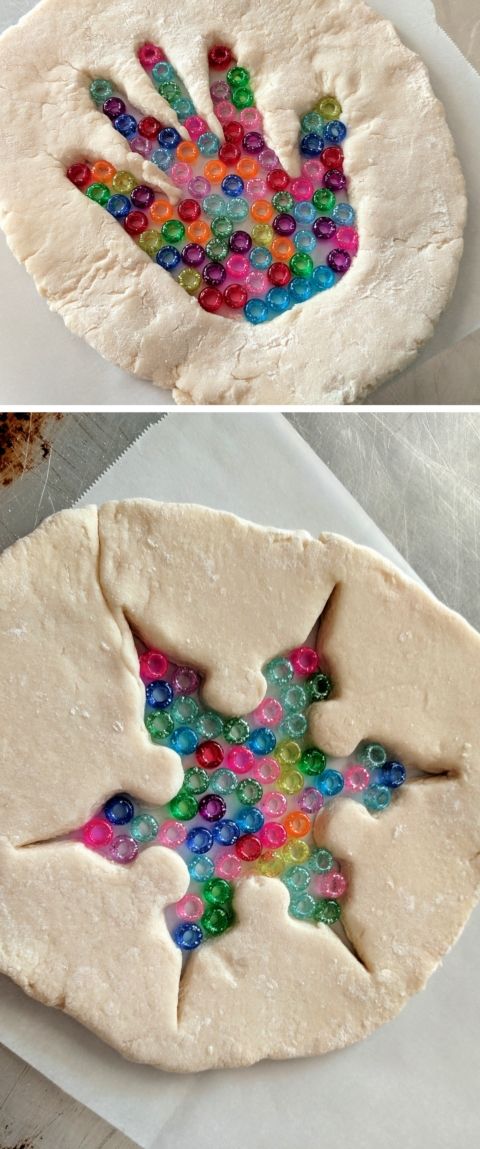 Regularly turn the product over so that it baked evenly on all sides. After finishing work, the craft immediately do not take it out - let it cool in the oven.
Regularly turn the product over so that it baked evenly on all sides. After finishing work, the craft immediately do not take it out - let it cool in the oven.
Vo drying time for salt dough refer to the following table.
| Low products (thickness up to 2 cm) | Volumetric work (more than 2 cm thick) |
| one hour at 50 °C | 1–2 hours at 50 °C |
| 1-2 hours at 75 °C | 2-3 hours at 75 °C |
| one hour at 100 °C | 1–2 hours at 100 °C |
| one hour at 125 °C | 2 hours at 125 °C |
0.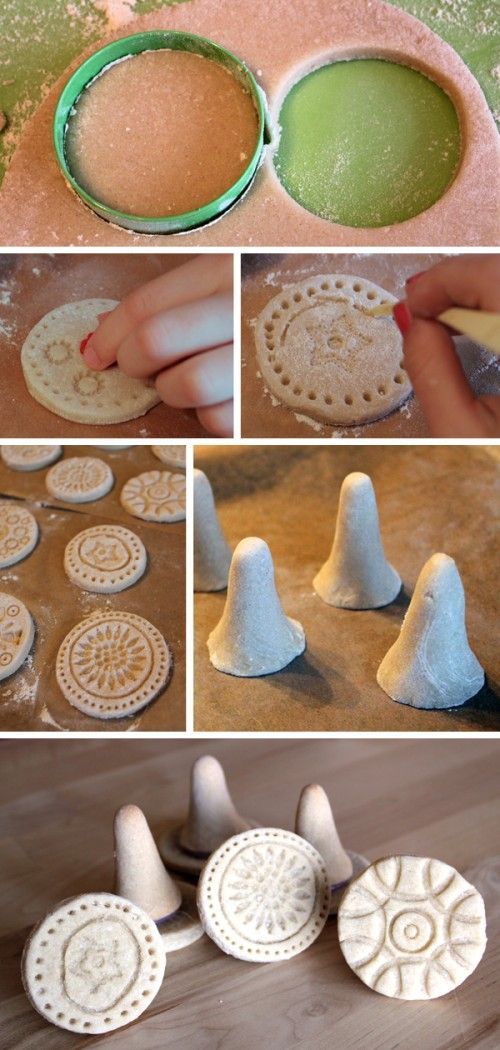 5–1 hour at 150 °C 5–1 hour at 150 °C | one hour at 150 °C |
Dry dough products can be turned off oven. Warm it up properly and put it down figurines in heat. Wait until the oven cool down. Repeat the process for several once.
In time to work with salt dough fail inevitable. However, don't be upset and put your hands down. If during the drying the craft is cracked or fell away from it detail, return the toy shape will help construction glue PVA or Moment.
cracks and irregularities can be smoothed out by small files for metal. Such for sure found in dad's tools.
Finished it is better to varnish the product - so it longer pleasing to the eye his talented master.
more sculpting ideas here:
- Mushroom polymer clay panel,
- Animals plasticine,
- Interesting plasticine products.
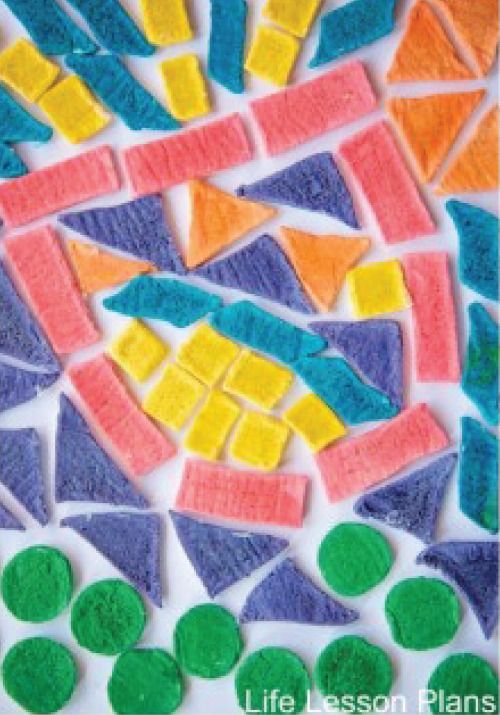
Learn more


